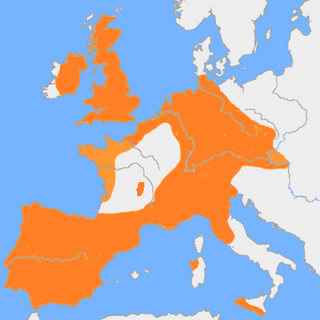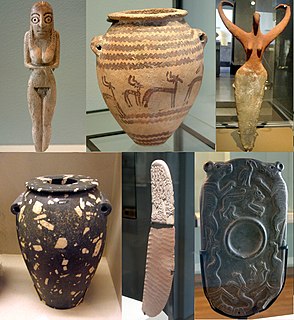Related Research Articles

The Bronze Age is a prehistoric period that was characterized by the use of bronze, in some areas proto-writing, and other early features of urban civilization. The Bronze Age is the second principal period of the three-age Stone-Bronze-Iron system, as proposed in modern times by Christian Jürgensen Thomsen, for classifying and studying ancient societies.

A weapon, arm or armament is any implement or device that can be used with intent to inflict damage or harm. Weapons are used to increase the efficacy and efficiency of activities such as hunting, crime, law enforcement, self-defense, and warfare. In broader context, weapons may be construed to include anything used to gain a tactical, strategic, material or mental advantage over an adversary or enemy target.

The 4th millennium BC spanned the years 4000 through 3001 BC. Some of the major changes in human culture during this time included the beginning of the Bronze Age and the invention of writing, which played a major role in starting recorded history.
The 26th century BC was a century which lasted from the year 2600 BC to 2501 BC.
The 30th century BC was a century which lasted from the year 3000 BC to 2901 BC.
The 33rd century BC was a century which lasted from the year 3300 BC to 3201 BC.
The 35th century BC in the Near East sees the gradual transition from the Chalcolithic to the Early Bronze Age. Proto-writing enters transitional stage, developing towards writing proper. Wheeled vehicles are now known beyond Mesopotamia, having spread north of the Caucasus and to Europe.

The Bell Beaker culture is an archaeological culture named after the inverted-bell beaker drinking vessel used at the very beginning of the European Bronze Age. Arising from around 2800 BC, it lasted in Britain until as late as 1800 BC but in continental Europe only until 2300 BC, when it was succeeded by the Unetice culture. The culture was widely dispersed throughout Western Europe, from various regions in Iberia and spots facing northern Africa to the Danubian plains, the islands of Great Britain and Ireland, and also the islands of Sicily and Sardinia.

Valentin Vasiliyevich Bondarenko was a Soviet fighter pilot selected in 1960 for training as a cosmonaut. He died as the result of burns sustained in a fire during a 15-day low-pressure endurance experiment in Moscow. The government concealed the death, along with Bondarenko's membership in the cosmonaut corps, until 1980. A crater on the Moon's far side is named after him.
In archaeology, the Carp's Tongue complex refers to a tradition of metal working from south eastern England to the later Bronze Age. It is part of the Ewart Park Phase that dates from the ninth century BC.

The prehistory of Egypt spans the period from the earliest human settlement to the beginning of the Early Dynastic Period around 3100 BC, starting with the first Pharaoh, Narmer for some Egyptologists, Hor-Aha for others, with the name Menes also possibly used for one of these kings. This Predynastic era is traditionally equivalent to the final part of the Neolithic period beginning c. 6000 BC and ending in the Naqada III period c. 3000 BC.
The Meldon Bridge Period is the name given by archaeologists to the earliest period of metalworking and the first period of the late Neolithic in Britain. It spans the period 3000 BC to 2750 BC and is named after the typesite of Meldon Bridge in Peeblesshire. Copper was used for the first time in the British Isles, initially in Ireland and then spreading east. Metalworking phases are divided into the Stage I Castletown Roche industries and the Stage II Knocknague/Lough Ravel industries. As well as metalworking, numerous other developments appeared in the archaeological record, including henges, stone circles, Peterborough ware, Grooved ware and cursus monuments.
The Overton Period is the name given by archaeologist Colin Burgess to a division of prehistory in Britain covering the period between 2000 BC and 1650 BC.
The Bedd Branwen Period is the name given by Colin Burgess to a division of the early Bronze Age in Britain covering the period between 1650 BC and 1400 BC. It follows his Overton Period and is superseded by his Knighton Heath Period.
The Knighton Heath Period is the name given by Colin Burgess to a phase of the Bronze Age in Britain following the Bedd Branwen Period and spanning the period 1400 BC to 1200 BC. It was succeeded by the Penard Period.

Vancouver-Mount Pleasant is a provincial electoral district for the Legislative Assembly of British Columbia, Canada. It was one of only two electoral districts to return an NDP MLA in the 2001 election when the NDP was nearly wiped off the electoral map, and it did so by a much wider margin than Vancouver-Hastings, the other seat to return a New Democrat.

The Pompeian Styles are four periods which are distinguished in ancient Roman mural painting. They were originally delineated and described by the German archaeologist August Mau, 1840–1909, from the excavation of wall paintings at Pompeii, which is one of the largest group of surviving examples of Roman frescoes.

Bronze Age Britain is an era of British history that spanned from c. 2500 until c. 800 BC. Lasting for approximately 1,700 years, it was preceded by the era of Neolithic Britain and was in turn followed by the period of Iron Age Britain. Being categorised as the Bronze Age, it was marked by the use of copper and then bronze by the prehistoric Britons, who used such metals to fashion tools. Great Britain in the Bronze Age also saw the widespread adoption of agriculture.

The District Council of Mount Pleasant was a local government area in South Australia from 1935 to 1997. The council seat was located at Mount Pleasant.
Colin B Burgess was an archaeologist specializing in the Bronze Age, especially in the north east of England and the Mediterranean.
References
Burgess, Colin (1980). The Age of Stonehenge (1st ed.). London: Dent. ISBN 0-460-04254-8.
| This article relating to archaeology in the United Kingdom is a stub. You can help Wikipedia by expanding it. |